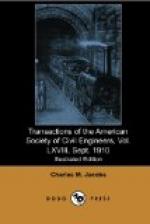Some exceedingly bad material was encountered in the deeper excavations, beds of quicksand being passed through, varying in thickness from 1 to 18 ft., the latter, in 31st Street between Seventh and Eighth Avenues, in the deepest excavation made. After encountering the fine sand in that trench, no headway was made until a tight wooden cylinder was sunk through the sand by excavating the material inside of it and heavily weighting the shell with pig iron. When this cylinder had reached the gravel, which lay below the sand, it was used as a sump, and the water level was kept below the bottom of the excavation, which permitted good progress. Sand continued to flow under the sheeting to such an extent, however, that the front walls of four adjoining buildings were badly cracked and had to be taken down and rebuilt. All the stoops along this trench settled, and had to be repaired.
The bench method of excavating for the retaining wall was very simple, and was used only where the rock lay near the surface and the adjoining buildings were founded on it, the overlying material being in such case dry, and consequently firm, little or no shoring was required. The method was to extend the pit excavation to a width of 2 or 3 ft. beyond the proposed back of the retaining wall, and to carry that width down to the depth required for its base, below which the excavation was narrowed to 1 ft. inside of the face of the wall and continued either before it was built or subsequently.
Retaining-Wall Construction.—The concrete walls were built in sections 50 ft. in length, except where that spacing would bring an expansion joint under a girder pocket or just on line with a tier of struts, in which cases the section was shortened as required. Trenches were never allowed to remain open at the full depth, the concreting being started as soon after the necessary length of rock had been uncovered as the forms and preliminary work for a section could be prepared. Each section was a monolith, except in a few cases where very heavy rains made it impossible to hold the laborers.
The various operations in building the concrete wall are shown on Fig. 7. Guide-planks, “a a,” Section “A-A,” were securely spiked to alternate tiers of struts for the length of the section, the face of each guide-plank being set on line with the intended face of the concrete wall, and 2-in. tongued-and-grooved spruce plank were laid along the guide-plank to the height of the bottom strut and securely braced from the front sheeting. A 4-in. brick wall was built simultaneously on line with the back of the wall to the height of the first step. Where the bottom strut was below that elevation, the brickwork was left low at that immediate point and built up when the strut was removed. The brick wall was then water-proofed on the side toward the concrete, and loose laps of the water-proofing were allowed to hang over the brickwork and at least




